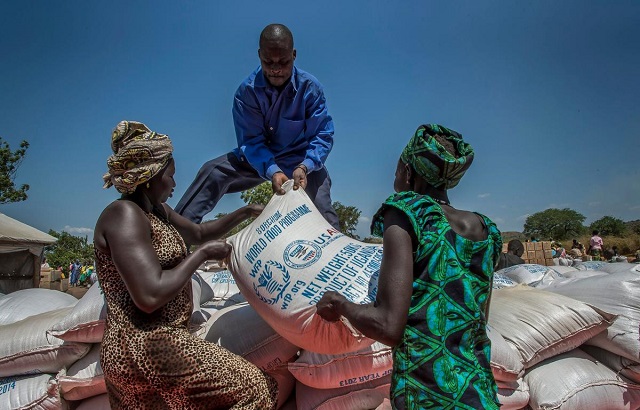
Food rights activists insist there is more to food insecurity in the sub-region than climate change
Kampala, Uganda | RONALD MUSOKE | High prices, conflicts, and weather shocks in certain areas will cause acute food insecurity in Uganda affecting 2.5 million people this year, according to the latest UN global report on food crises (GRFC).
The Global Report on Food Crises is the flagship publication of the Global Network Against Food Crises (GNAFC), an international alliance of the United Nations, the European Union, governmental and non-governmental agencies, working to tackle food crises together. It is produced by the Food Security Information Network (FSIN).
Founded in 2016, the Global Network Against Food Crises brings together the European Union, the UN Food and Agriculture Organization (FAO), UNICEF, the United States of America, the United Nations World Food Programme (WFP) and the World Bank in a unique partnership to improve analysis, evidence and consensus on the prevalence and severity of food crises; improve collective efforts to prevent and respond to these crises; and improve understanding of the underlying causes and interlinkages between food crises and other shocks beyond food.
Since 2016, the report has been providing a comprehensive global picture on the scale and magnitude of food crises by compiling the main global, regional and national food security analyses through a transparent and consensus-based process involving 16 international humanitarian and development partners, and aimed at informing and promoting timely, cost-efficient and need-based humanitarian, as well as resilience building actions.
57 million East Africans are food insecure
The eastern African countries with the largest population mentioned to be facing high levels of acute food insecurity are Ethiopia (23.6 million), followed by The Sudan (11.7 million), South Sudan (7.7 million), Somalia (5.59 million), Kenya (4.4 million) and Uganda (2.5 million).
These countries are considered to be facing major food crises based on the different levels of severity of acute food insecurity in five distinct phases: (1) Minimal/None, (2) Stressed, (3) Crisis, (4) Emergency, (5) Catastrophe/Famine.
The report says extreme weather events including three consecutive droughts in the Horn of Africa coupled with economic challenges are driving millions of people in eastern Africa into ‘acute food insecurity.’
The UN report which was released on May 4 in Rome notes that although significant efforts in the scale-up of multi-sectoral humanitarian assistance, supported by slightly more favourable than foreseen rains are contributing to a moderate improvement in some areas in the sub-region, livelihood recovery will still take time.
“This crisis demands fundamental, systemic change,” António Guterres, the UN Secretary-General wrote in the foreword of the report.
The report says the compounding effects of multiple shocks, including drought, macroeconomic challenges and conflict, have driven nearly 56.85 million people in the sub-region into a crisis. Weather extremes were considered the primary drivers of acute food insecurity in Burundi, Ethiopia, Kenya, Somalia, and Uganda where a combined total of 37.26 million people faced high levels of acute food insecurity.
The Horn of Africa has faced unprecedented three-year drought with southern Ethiopia, the arid and semi-arid lands of Kenya and most of Somalia being worst affected. Both Burundi and Uganda were affected by rainfall deficits in 2022 that constrained crop yields while record breaking flooding was observed in South Sudan.
In Uganda, weather shocks, high food prices and conflict in certain areas are expected to drive acute food insecurity with up to 2.5 million people projected to face high levels of acute food insecurity in 2023, up from 2.3 million in 2022 according to the Famine Early Warning Systems Network (FEWSNET) of the United States Agency for International Development (USAID).
The FEWSNET is a website of information and analysis on food for governments, international relief agencies, NGOs, journalists, and researchers planning for, responding to, and reporting on humanitarian crises.
The report describes “acute food insecurity” as a situation when a person’s inability to consume adequate food puts their lives or livelihoods in immediate danger. It draws on internationally accepted measures of acute hunger, such as the Integrated Food Security Phase Classification (IPC) and the Cadre Harmonisé (CH). However, this, the report notes, is not the same as chronic hunger, as reported on each year by the UN’s annual State of Food Security and Nutrition in the World (SOFI) report.
Gloomy global picture
At a global level, the number of people experiencing acute food insecurity and requiring urgent food, nutrition and livelihood assistance increased for the fourth consecutive year in 2022, with over a quarter of a billion facing acute hunger and people in seven countries on the brink of starvation, according to the report.
It notes that around 258 million people in 58 countries and territories faced acute food insecurity at crisis or worse levels (IPC/CH Phase 3-5) in 2022, up from 193 million people in 53 countries and territories in 2021.
This is the highest number in the seven-year history of the report. However, the report noted, much of this growth reflects an increase in the population analyzed. In 2022, the severity of acute food insecurity increased to 22.7%, from 21.3% in 2021, but remained unacceptably high and underscored a deteriorating trend in global acute food insecurity.
“More than a quarter of a billion people are now facing acute levels of hunger, and some are on the brink of starvation. That’s unconscionable,” said António Guterres.
“This seventh edition of the Global Report on Food Crises is a stinging indictment of humanity’s failure to make progress towards Sustainable Development Goal-2 to end hunger and achieve food security and improved nutrition for all.”
According to the report, more than 40% of the population in IPC/CH Phase 3 or above resided in just five countries – Afghanistan, the Democratic Republic of the Congo, Ethiopia, parts of Nigeria (21 states and the Federal Capital Territory), and Yemen.
People in seven countries faced starvation and destitution, or catastrophe levels of acute hunger (IPC/CH Phase 5) at some point during 2022. More than half of those were in Somalia (57%), while such extreme circumstances also occurred in Afghanistan, Burkina Faso, Haiti (for the first time in the history of the country), Nigeria, South Sudan and Yemen.
Around 35 million people experienced emergency levels of acute hunger (IPC/CH Phase 4) in 39 countries, with more than half of those located in just four countries – Afghanistan, the Democratic Republic of the Congo, the Sudan and Yemen.
Additionally, in 30 of the 42 main food crises contexts analyzed in the report, over 35 million children under five years of age suffered from wasting or acute malnutrition, with 9.2 million of them with severe wasting, the most life-threatening form of undernutrition and a major contributor to increased child mortality.
While conflicts and extreme weather events continue to drive acute food insecurity and malnutrition, the economic fallout of the СOVID-19 pandemic and the ripple effects of the war in Ukraine have also become major drivers of hunger, particularly in the world’s poorest countries, mainly due to their high dependency on imports of food and agricultural inputs and vulnerability to global food price shocks.
And going by the 2023 projections available for 38 of the 58 countries/territories as of March 2023, up to 153 million people (or 18% of the analyzed population) will be in IPC/CH Phase 3 or above. In addition, around 310 000 people are projected to be in IPC/CH Phase 5 across six countries – Burkina Faso, Haiti, Mali, parts of Nigeria (26 states and the Federal Capital Territory), Somalia and South Sudan, with almost three quarters of them in Somalia.
Shift in attitude
Going forward, the international community has called for a paradigm shift towards better prevention, anticipation and targeting to address the root causes of food crises, rather than responding to their impacts when they occur.
This requires innovative approaches and more coordinated efforts by international organizations, governments, the private sector, regional organizations, civil society and communities. The activities should focus on more effective humanitarian assistance, including innovative approaches such as anticipatory actions and shock-responsive safety nets.
From a development perspective, it is of utmost importance to scale up core investments to tackle the root causes of food crises and child malnutrition. This entails making agrifood systems more sustainable and more inclusive– including through the use of nature-based solutions, inclusive access to food and better risk mitigation.
The report notes that conflicts, national and global economic shocks and weather extremes will continue to be increasingly intertwined and will fee into one another and create spiraling negative effects on acute food insecurity and nutrition.
“There is no indication that these drivers will ease in 2023: climate change is expected to drive further weather extremes, the global and national economies face a grim outlook, while conflicts and insecurity are likely to persist.”
There is also a need for increased investments in the prevention, early detection and treatment of child wasting. For UN Secretary General Guterres, the report makes clear that progress is possible.
“We have the data and know-how to build a more resilient, inclusive, sustainable world where hunger has no home including through stronger food systems, and massive investments in food security and improved nutrition for all people, no matter where they live.”
Meanwhile, Agnes Kirabo, the executive director of Food Rights Alliance, a coalition that brings together civil society organizations working in the field of sustainable agriculture and food security told The Independent that it is high time the governments in eastern Africa region stopped blaming the food insecurity situation on climate change.
“Climate change is a reality. Focusing and lamenting about nature will never stop nature from wreaking havoc,” she told The Independent. Kirabo wants governments in this region to put a little more focus on agriculture and food systems.
“These governments must go for strategic investments. Whether it rains or not people are going to need food. Investment in infrastructure and safety nets could, for instance, allow the movement of food from areas of plenty to areas of scarcity. More investments are also needed in post- harvest handling losses.”
David Kabanda, a social rights lawyer who doubles as the executive director of the Centre for Food and Adequate Living Rights also told The Independent that food is a fundamental human right but many countries in eastern Africa don’t have clear policies and legal frameworks that speak to, for instance, establishing national food reserves.
“We acknowledge that climate change is happening but climate change is not solely responsible for causing food insecurity in Uganda or eastern Africa,” he told The Independent, “It’s just a failure of our leaders who willingly or inadvertently are conniving with multinational corporations. How on earth can people die in this age yet in this same country, Uganda, there are areas with plenty of food.”
 The Independent Uganda: You get the Truth we Pay the Price
The Independent Uganda: You get the Truth we Pay the Price


